By Sean Reid

I must start by saying that the following is not a review or even a mini-review. Michael has asked me to share some of my impressions of the Ricoh GXR-A12 and these comments, of course, certainly won’t cover all aspects of the camera (they are not intended to). In fact, what I primarily want to do here is to look at how the the GXR, as a type of camera, might fit into the range of digital camera options we have in 2010.
I want to thank photographerMitch Allandwho provided the first two pictures that illustrate this essay. The product pictures of the camera components were provided by Ricoh Japan and the other illustrations were made by the author.
Over the past few years, Ricoh has developed a strong, if somewhat quiet, reputation as a maker of high quality small sensor cameras for serious photographers. I described their original GR Digital model, first introduced in 2005, as a “pocket sketchbook”. With a fixed 6 mm (28 mm EFOV) lens, a rugged body and intelligently designed manual controls, the GR digital cameras have a strong following and have been important tools for the work of various photographers. And, not surprisingly, each new version of the GR has improved upon the weaknesses of the prior model.
But, of course, not all photographers want to work at a 28 mm EFOV. So Ricoh also makes a “GX” line of cameras which can essentially be understood as zoom lens alternatives to the GR models. Though the GR and GX models are not identical, they share many ergonomic features and a common design “gestalt”.

Not unlike Leica, Ricoh’s higher end models have tended to appeal to serious photographers in a specific niche of the market: high quality small sensor cameras with full manual controls. For Leica, of course, those niches are currently the digital rangefinder (DRF), the medium sensor “pocket camera” (with traditional exposure controls) and now, with the S2, the integrated, sealed and relatively compact medium format digital camera. For both Ricoh and Leica, these are good niches to be working in and many photographers are no doubt glad that such types of digital cameras exist as alternatives to the mainstream 35 mm format DSLR.
The current Ricoh GR Digital III and GX 200 are, in my opinion, among the best small sensor cameras currently made for serious photographers. But while many photographers like the compact size of these cameras, not all of them want to work in the small sensor format. There are pros and cons to this format but until the recent past it was the only option available for photographers who wanted a “pocket sized” digital camera. That restriction lifted when Sigma introduced their first compact medium sensor camera, the DP1. Since then we’ve also seen the introduction of Sigma’s DP2 and Leica’s X1, both cameras that use medium-sized sensors while still fitting into a jacket pocket. Then, of course, there are also three Micro Four-Thirds (mFT) cameras currently available that, while not quite pocket sized, are still relatively light and compact when paired with small lenses. One such combination is the Panasonic GF1 with 20/1.7 lens and another is the Olympus Pen EP-2 with 17/2.8 lens.
In the midst of a compact camera market (for serious photographers) that is developing in these ways, Ricoh had at least two directions they could consider. One would be to develop variations of the GR with prime lenses of other focal lengths (35 and 50 mm EFOV versions for example). Another would be to develop compact cameras with medium sized sensors (as Sigma and Leica have done). With the introduction of the GXR, Ricoh has essentially gone in both of these directions at once while creating a new niche – the compact modular digital camera.
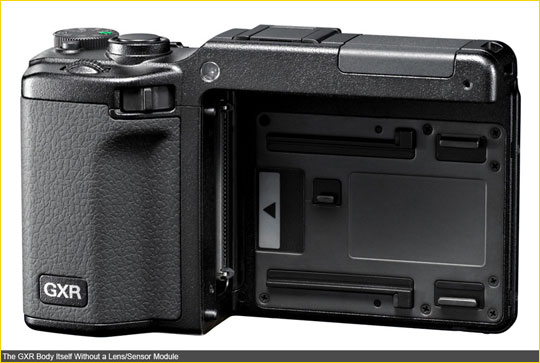
The GXR camera body itself is, in many respects, a somewhat larger sized version of the rugged and well-designed Ricoh GR III camera body. As such, many of the controls of the GXR are variations on controls that will be readily familiar to photographers who’ve worked with either GR or GX series cameras. But unlike the integrated GR III and GX200, the GXR body is a modular component into which one can mount different models of integrated lens/sensor units. Initially, Ricoh introduced two lens/sensor units (which they refer to simply as “lenses”) for the GXR. The first, called the A12, pairs a medium (roughly APS-C) sized sensor with a 33 mm F/2.5 lens that gives a 50 mm EFOV. The second, called the S10, pairs a small sensor with a zoom lens that gives about a 24 – 72 mm EFOV and has a maximum aperture that ranges from F/2.5 to F/4.4 (depending on its focal length setting).
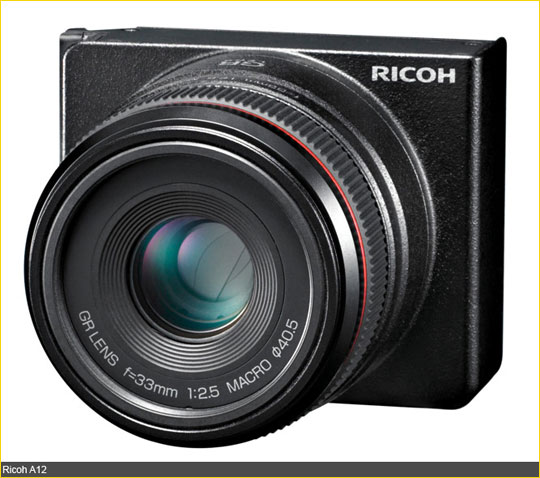
Recently, however, Ricoh announced two more lens units for the GXR. The first is a 28 mm (EFOV) F/2.5 version of the A12 unit. Its actual focal length is probably about 19 mm. I don’t yet have an example copy of this lens to test but it seems as if it might be roughly the same size as the Panasonic 20/1.7 mFT lens. If that’s the case, the GXR with this lens module mounted may be compact enough to fit in a large jacket pocket.
The second lens unit announced for the GXR is called the P10 and it features a small sensor paired with a 28 – 300 (EFOV) lens with a maximum aperture that varies from F/3.5 to F/5.6 (depending on its focal length setting).
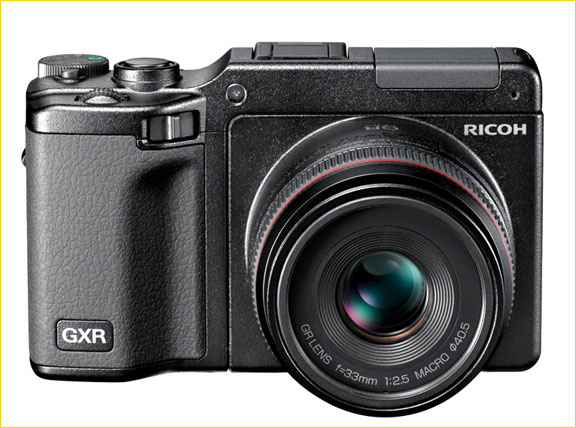
The A12’s sensor size puts the GXR-A12, in some respects, in competition with Leica’s X1. In fact, it seems possible to me that the two cameras use either the same Sony sensor or two sensor units that are very similar. But while the sensors in the Ricoh and Leica may be similar, the two cameras are quite different in concept (beyond the obvious difference of a modular body vs. fixed lens design). The Leica uses a 24 mm (35 mm EFOV) F/2.8 retractable lens that allows the camera to fit into a large jacket pocket. The current GXR-A12 uses a 33 mm (50 mm EFOV) F/2.5 lens that makes the camera too large to fit in a typical coat pocket. So while the GXR-S10 can certainly be thought of as a pocket camera the “50 mm” version of the GXR-A12 cannot. But the new “28 mm” version of the A12 unit, as discussed above, may be compact enough that a GXR using that module, while still larger than an X1, will fit in a large jacket pocket.
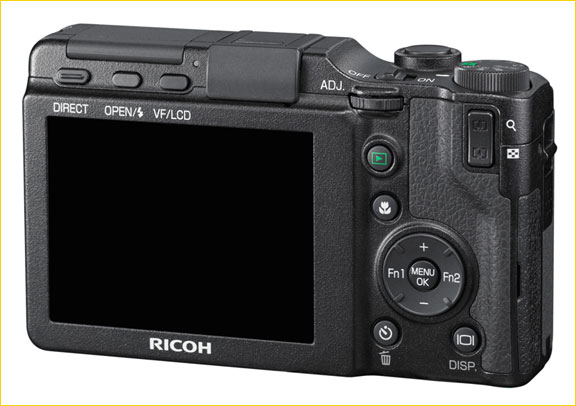
Ricoh’s decision to create a modular compact camera system is very interesting. Most medium format digital camera systems, as a rule, are modular. Photographers who like a particular camera body can potentially use it with different medium format backs. As time goes on the resolution of these backs (in MP) increases, costs decrease, etc. So photographers can upgrade parts of their medium format digital systems without necessarily needing to replace the core camera body (or bodies) they use. By the same token, they can also use the same set of lenses with various bodies and backs.
35 mm format DSLR and DRF systems, by contrast, tend to be grounded in whatever lens sets a photographer develops. A given set of lenses may be used for many years while the digital bodies attached to those lenses changes. If one wants the performance increases that come with new sensors (and their related electronics) he or she needs to replace an entire camera body. The same can be said for 4/3 system cameras, mFT system cameras, etc. So we can think of systems like this as being partly modular – lenses, flashes, cables, etc. may stay as constants while camera bodies are changed.
But with the GXR, as with many medium format digital systems, one particular baby needn’t necessarily be thrown out with the bathwater. If one is satisfied with the basic feel and functionality of the GXR body then his or her system evolution can happen through the purchase of various lens/sensor modules. One might change modules in order to work with a different sensor size, a different focal length, a faster maximum aperture, higher resolution, etc.
On the other hand, the GXR throws a different baby out with each change of bathwater. In order to change the sensor one must also change the lens. So even if one likes the performance of his or her 33 mm A12 lens, for example, he or she cannot use it with a newer sensor. The two need to be swapped at once because they are part of the same physical unit. As several photographers have observed, the GXR pairs the lens (a component of a camera system that one often keeps long term) with the sensor (a component of the camera system that one tends to change most often – normally by changing camera bodies). So with a typical DSLR one must give up the camera body in order to gain a new sensor. With the GXR, one must give up a lens to gain a new sensor.
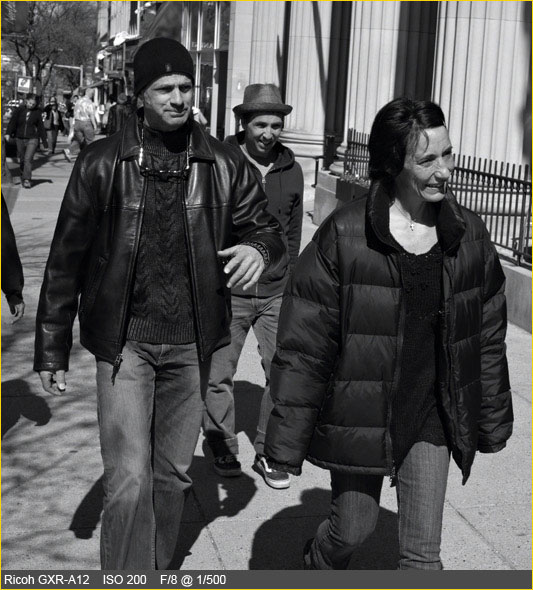
Which is the greater compromise? There’s no one answer to that. The advantage to the GXR is that if one really likes the camera’s body and viewfinder system he or she will be able to stay with familiar controls, familiar finders, etc. as he or she changes lens/sensor modules. In general, the ergonomics of a new camera body take longer to get used to than the ergonomics of a new camera lens. These A12 lenses, for example, have only one control – a focus ring – and so getting accustomed to the ergonomic changes that come with a new GXR lens may not be very difficult.
A typical DSLR, DRF or mFT body allows one to work with a core format and aspect ratio while changing lenses. The GXR allows one to work with a core body while changing both the format/aspect ratio and the lens. In other words, the GXR might be particularly useful to photographers who like to work in both the small sensor and medium sensor formats. In terms of the actual pictures made by the camera, that’s the GXR’s primary distinction. One can start the day working with the coarser drawing and deep depth of field of a small sensor camera and then move to the lower noise, more subtle rendering and shallower depth of field of a medium sensor camera – all while using the same body.
As of this writing, there’s no provision for keeping the same sensor in the GXR while changing only the lens. That’s not to say, however, that Ricoh couldn’t introduce separate GXR lenses and sensor/lens mount units down the road. They could develop their own lenses (which they’re already doing, essentially, in order to make these lens/sensor modules) or they could consider offering a module with an mFT mount. It might even be interesting if they developed a sensor/lens mount unit at some point that was optimized for use with Leica M lenses.

In theory, the idea of creating a GXR sensor module with a lens mount is contrary to Ricoh’s vision for the GXR system. Specifically, one theoretical advantage of this modular system is that the paired lens and sensor in a given module are matched to each other so that they perform well. This would imply, for example, that the anti-aliasing filter and micro-lens design in each module is tailored to the specific lens used. And, in fact, the A12’s lens and sensor/microlenses/filters do seem to be well combined. But while Ricoh’s idea certainly has advantages, in theory, it hasn’t always proven to be necessary in practice. If fact if it were always necessary, DSLR systems would have been in a lot of trouble from the start.
When Olympus introduced the 4/3 system, they specifically stressed that the new lenses they created for that system would be optimized for use with 4/3 sensor cameras. They weren’t pairing one lens with one sensor but rather one set of lenses with one system of cameras. And history has shown so far that their plan for this seems to have worked out well. I don’t work with a 4/3 system myself but photographers who do seem to report that many of the Olympus 4/3 lenses perform quite well. And, certainly, the 4/3 lenses I’ve used myself have performed well on 4/3 bodies. Nikon (and Zeiss for that matter) have a number of lenses that work very well on Nikon DSLRs. Canon (and Zeiss again) also make a number of lenses that work well on their DSLRs.
So the reality, as I see it, is that while a paired lens/sensor module certainly might work very well we can also see ample evidence (in the short history of digital camera systems to date) that system lenses often work quite well with system cameras. One doesn’t necessarily need to pair a specific lens with a specific sensor/micro-lens unit to get high performance from a digital camera.
So if Ricoh were to introduce a sensor module with a mount for new, GXR system, lenses I don’t see any reason why those lenses could not perform well. If Olympus, Panasonic and others can make different lenses and bodies that work well together I imagine think that Ricoh could do the same.
Another theoretical advantage of the fixed lens/sensor module is that it is sealed against the entry of dust and dirt. And that is indeed an advantage so long as dust and dirt never make their way into the system. But if they did, of course, there’s no simple way to clean the filter in front of the sensor. I have not yet seen any evidence of internal dust in my A12 test unit and I think as more and more people use these modules over time we’ll find out how dust resistant they are. So far, I’ve heard just one report of dust spots appearing in pictures made with the A12 and Ricoh apparently replaced that unit under warranty.
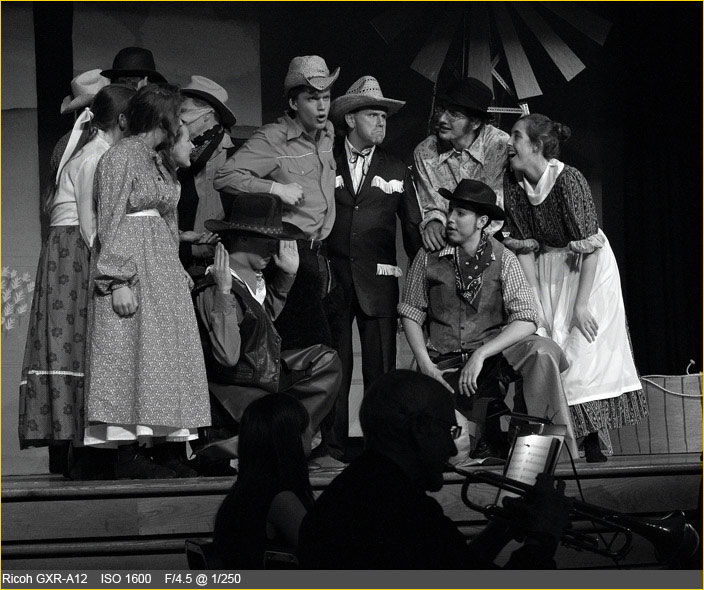
Overall, the file quality from the GXR-A12 is excellent, even at high ISO levels. In fact it is similar in many ways to output from the Leica X1 or a DSLR with a sensor of the same size. The files are fairly robust and so can be worked fairly extensively in post-processing without falling apart. The camera’s auto-focus, however, is slower than that of a typical DSLR and so one must allow for that focusing time before making an exposure. In single shot mode (recording DNGs), the camera also delays a few seconds between exposures. So, with respect to both auto-focus and speed in RAW mode, this is not a fast camera.
This Ricoh is also, first and foremost designed to be used with electronic finders – either its rear LCD screen or an optional eye-level EVF. And, as such, it features many of the same strengths and weaknesses we see in various cameras that use electronic screens as finders. The external VF-2 EVF is competent but lacks the detail one sees in, for example, the eye-level finder of a Panasonic G1 (which has the best and most detailed EVF I’ve used to date). The question of finders and their effects on our photography is too broad to consider here but I recommend that anyone considering the GXR-A12 stop to think about how suitable electronic finders are for his or her work. In fact I recommend that one think carefully about the finder system of any camera he or she is considering buying. The finder, after all, is central to seeing the subject and seeing the subject is at the heart of our work as photographers.
One can mount an external 50 mm optical finder on the GRX-A12 but the camera’s hot shoe is slightly horizontally offset relative to the lens. So there’s a bit more parallax than one would see when using an optical finder on a Ricoh GR III, for example. As of this writing, the GRX-A12 also lacks an “Optical Viewfinder Mode” so the only way to get quick access to key controls, while using an OVF on the camera, is to leave the camera’s rear LCD on whenever one is photographing.
The originality of the GXR’s modular design is exciting and the uniqueness of the camera, all by itself, will likely make it appealing to some photographers. But setting aside the novelty of the modular camera concept, it makes sense to consider what one gains with the GXR-A12 and what he or she gives up (compared to a DSLR, a DRF or another camera type). Ricoh has done something important and interesting by creating the modular compact camera. How well the strengths and weaknesses of this new camera type will suit a given photographer can only be judged by that person individually.
April, 2010
____________________________________________________________________________________
Sean Reid, an American, has been a commercial and fine art photographer for over twenty-three years. He studied under Stephen Shore and Ben Lifson and met occasionally with Helen Levitt. In the late 1980s he worked as an exhibition printer for Wendy Ewald and other fine art photographers. In 1989, he was the first American photographer to receive an artist-in-residence grant from the Irish Arts Council in Dublin, Ireland. His commercial work is primarily of architecture, weddings and special events. His personal work is primarily of people in public places. Having worked mostly with large format and rangefinder cameras for many years, he now works primarily with the Leica M8 and Canon DSLRs. Most of his newest reviews and other articles can be found at Reid Review.http://www.reidreviews.com.
You can find a much more comprehensive review of theRicoh GX12at Seans site,http://www.reidreviews.com. This is a subscription site, and in my opinion well worth your consideration.
You May Also Enjoy...
Better Beamer
Success‚ In a Flash Most photographers understand the benefits of using fill flash under harsh lighting conditions. Most modern cameras using either built-in flash heads
